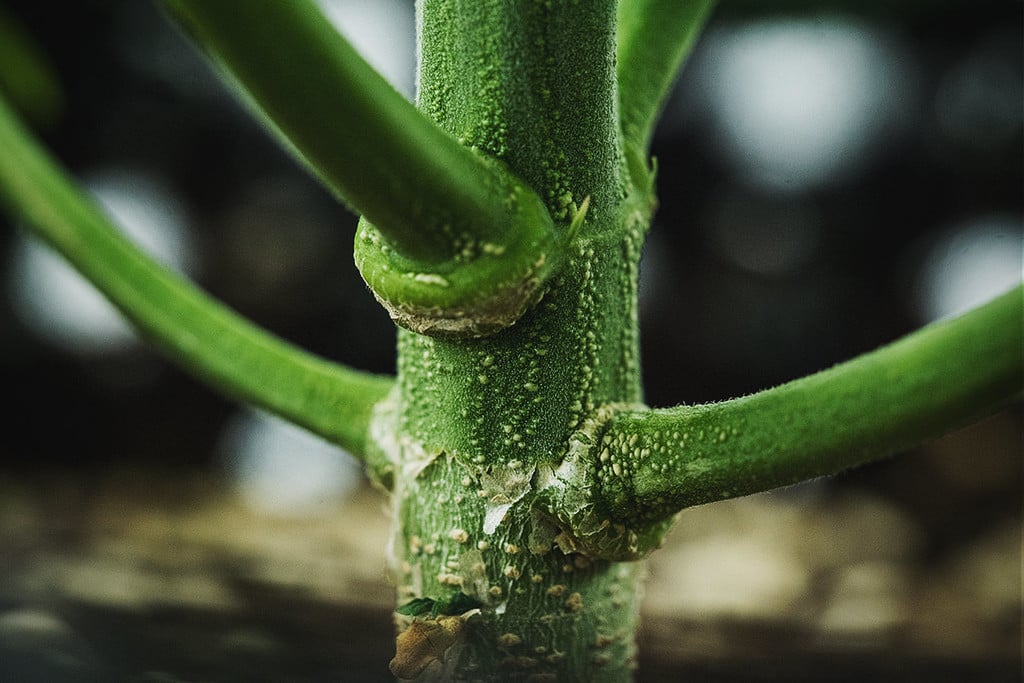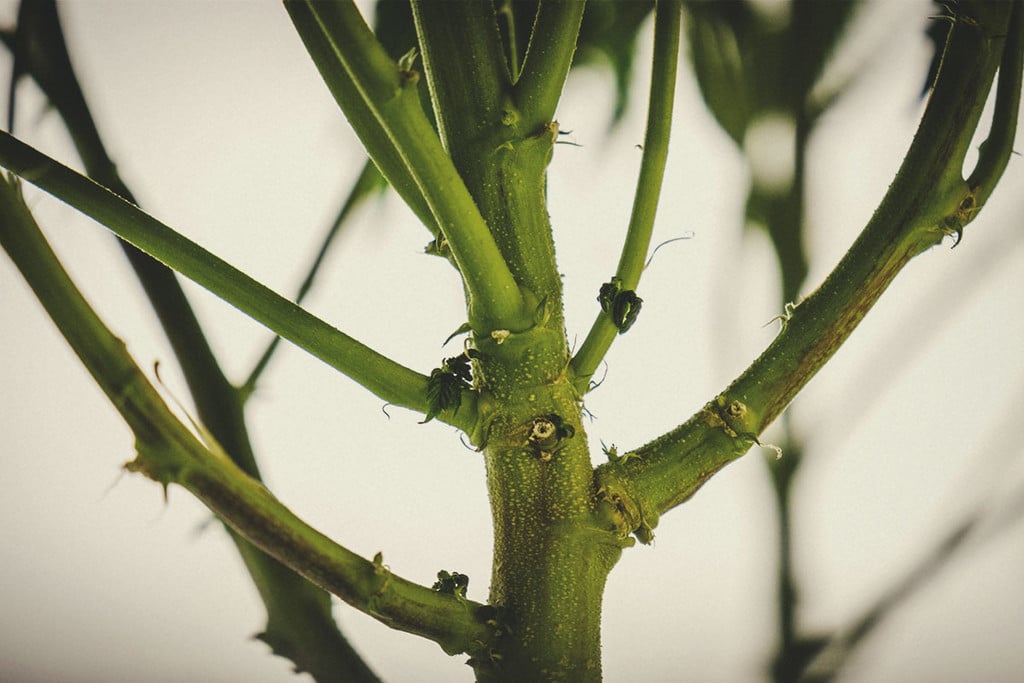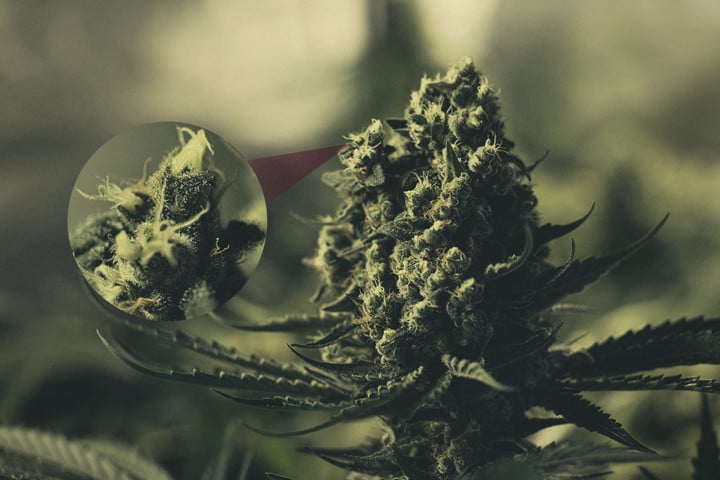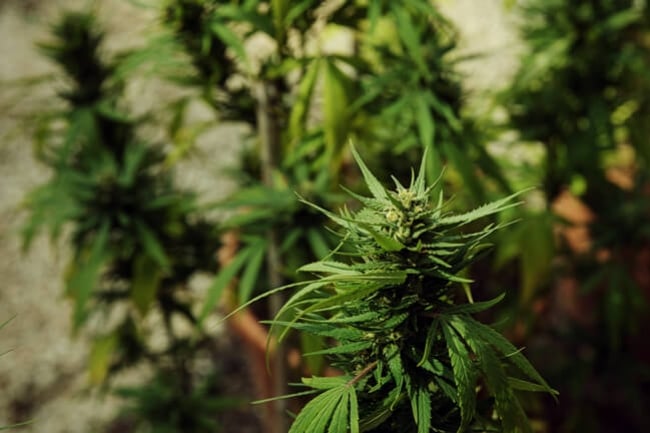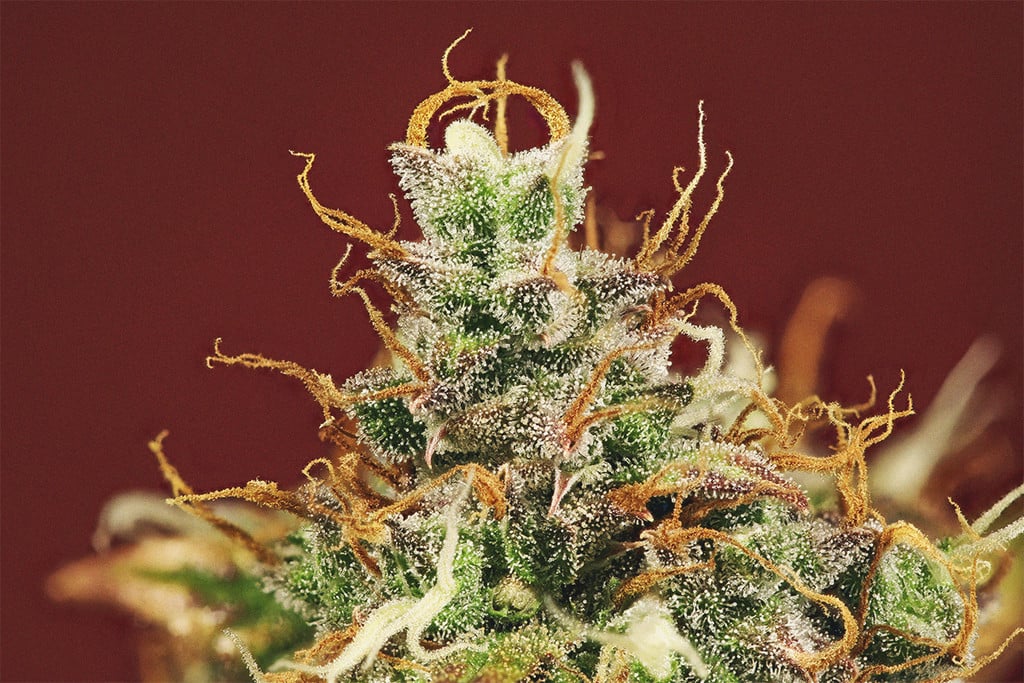 Cannabis Grow Guide by Royal Queen Seeds
Cannabis Grow Guide by Royal Queen Seeds
- Growing cannabis step by step
- Cannabis growing basics
- Choosing your seeds
- How to germinate seeds
- The cannabis vegetative stage
- The cannabis flowering stage
- Harvesting cannabis
- Trimming, drying, and curing
- Choosing pots and soil
-
Growing indoors
- A Complete Overview Of Growing Cannabis Indoors
- Cannabis Cultivation Tips: How To Set Up Indoor Grow Lights
- How Many Cannabis Plants Can You Grow Per Square Metre?
- Indoor Cannabis Growing: Relative Humidity and Temperatures
- Hydroponics Cannabis Growing Guide (with diagrams)
- Cannabis Micro Growing: Growing Great Weed in Tiny Spaces
- Growing outdoors
- How to grow autoflowering cannabis
- Cannabis nutrients and pH
- Cannabis troubleshooting: Nutrients
-
Cannabis troubleshooting: Growing
- Cannabis Seed Germination — Troubleshooting Guide
- How to Deal With Pythium (Root Rot) in Cannabis Plants
- Slow Cannabis Plant Growth And What You Can Do About It
- How to Deal With Leggy Cannabis Seedlings
- Watering Your Cannabis: How to Fix Overwatering and Underwatering
- Understanding Male, Female, And Hermaphrodite Cannabis
- Identifying and Treating Common Cannabis Ailments
- How To Revive a Sick Cannabis Plant
- How to Avoid Mouldy Weed During Drying and Curing
- How to Prevent and Treat Dry and Crispy Cannabis Leaves
- What Cannabis Leaves Can Tell You
- Causes and Solutions for Yellow Cannabis Leaves
-
Cannabis Strains Grow Report
- HulkBerry Automatic Grow Report
- Blue Cheese Auto Grow Report
- Purple Punch Automatic Strain Grow Report
- Triple G Automatic Grow Report
- Do-Si-Dos Automatic Grow Report
- Green Gelato Automatic Grow Report
- Haze Berry Automatic Grow Report
- Purple Queen Automatic Grow Report
- Cookies Gelato Automatic Grow Report
- Sherbet Queen Automatic Grow Report
- Sweet Skunk Automatic Grow Report
- Medusa F1 Grow Report
- Cannabis plant training
-
Weed growing tips
- The Cannabis Plant Anatomy
- How to preserve seeds
- How Much Sunlight Do Outdoor Cannabis Plants Need To Grow?
- How to Control and Prevent Stretching in Cannabis Plants
- My Cannabis Plants Are Growing Too Tall: What Should I Do?
- Should You Worry About Purple Or Red Cannabis Stems?
- What To Do When Your Indoor Cannabis Won’t Flower
- How To Protect Your Cannabis Plants From Heat Stress
- How To Tell If Your Female Cannabis Plant Has Been Pollinated
- Growing Medical Marijuana
- Bud Washing: How to Clean Your Weed
- Understanding Cannabis Yield per Plant
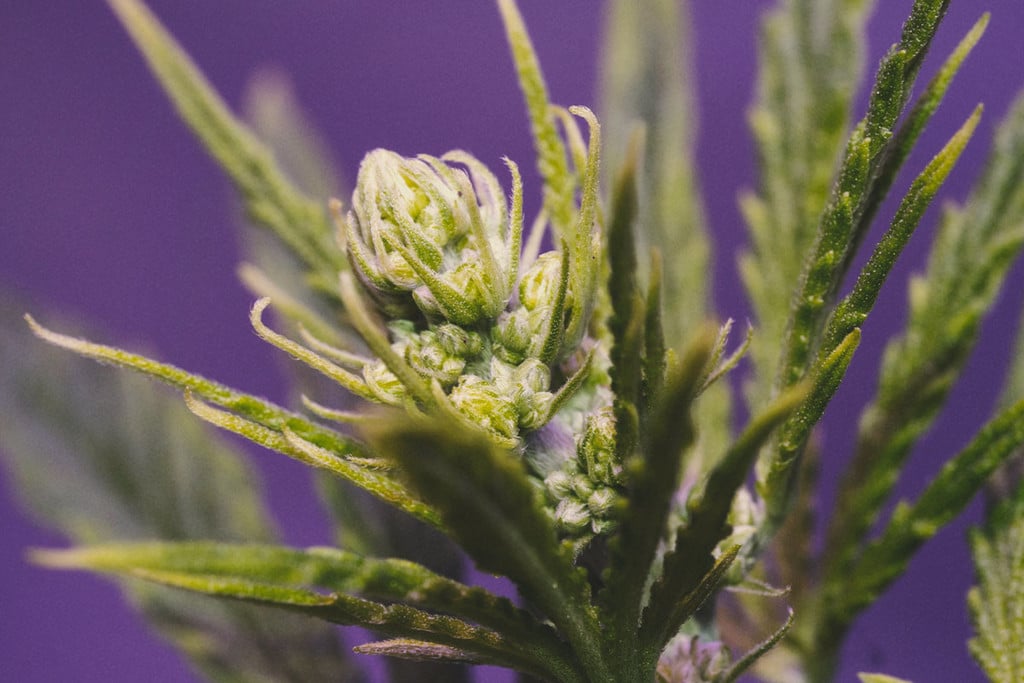
Understanding Male, Female, And Hermaphrodite Cannabis
A guide to differentiating between male, female, and hermaphrodite cannabis plants.
Contents:
- Why does it matter that cannabis is dioecious?
- Male vs female cannabis: what's the difference?
- Hermaphrodites: when cannabis plants become monoecious
- Can you tell if your plant is male or female before flowering?
- How to identify different sexes of cannabis plants: sexing cannabis
- Types of hermaphrodite cannabis plants
- How to avoid hermaphrodite plants in your grow room
- How long does pollen last in a grow room?
- What type of cannabis seeds are used for breeding?
- Can you tell the sex of a cannabis seed?
From psychoactive cannabinoids to aromatic terpenes, cannabis features many traits that make it unique within the plant kingdom. However, the uniqueness of the plant doesn’t stop at the phytochemicals it produces.
See, the vast majority of plant species are monoecious, a term meaning they possess both male and female reproductive organs in the same plant. These include edible plants, such as corn and squashes, that can readily fertilise their own flowers using their own pollen.
Cannabis belongs to a minority of species that are dioecious in nature, meaning they produce separate male and female plants. Specifically, it should be noted that only 5-6% of all angiosperms (flowering plant species) possess this rare and interesting trait.
Why Does It Matter That Cannabis Is Dioecious?
Cannabis growers and breeders use this trait to their advantage, since it allows them to separate male and female plants. This enables growers to prevent the flowers from becoming fertilised and going to seed, which results in better-quality flowers, known as sinsemilla.
It also means cannabis breeders have more control when it comes to crossing specific males and females together. They can choose two healthy and vigorous specimens, place them close together, and produce progeny that express certain traits.
Let’s take a deeper look into male and female cannabis plants. From there, we’ll see what causes some specimens to develop both male and female reproductive organs.
Male vs Female Cannabis: What's The Difference?
Male and female plants look identical during the seedling and vegetative phases. But, as they begin to transition into the flowering phase, plants finally begin to reveal their sex. During this time, females produce resinous buds loaded with cannabinoids, and males form sacs filled with pollen.
Female cannabis plants are the main focus of casual growers looking to harvest a personal stash. But, depending on their genetics, female plants can look drastically different from one another. Some remain small, producing dense canopies and significant lateral growth. Others grow in excess of 3m, produce massive harvests, and look more like trees than regular garden plants.
Despite their differences, all female plants share one thing in common: they produce female flowers. These flowers, colloquially known as buds, possess small glandular structures called trichomes that produce cannabinoids such as THC and CBD.
Male plants, in contrast, don’t produce female flowers. This makes them less valuable for growers seeking only buds. However, they do produce pollen sacs. These small vessels create the genetic material required to fertilise female flowers and produce seeds. This makes the males extremely important for breeding new cannabis strains.
It should also be noted that male pollen sacs and female flowers develop at the same point on the plant. Both structures emerge from nodes, the point at which branches meet the main stem. So, when you see buds starting to form on some plants, start looking for pollen sacs too.
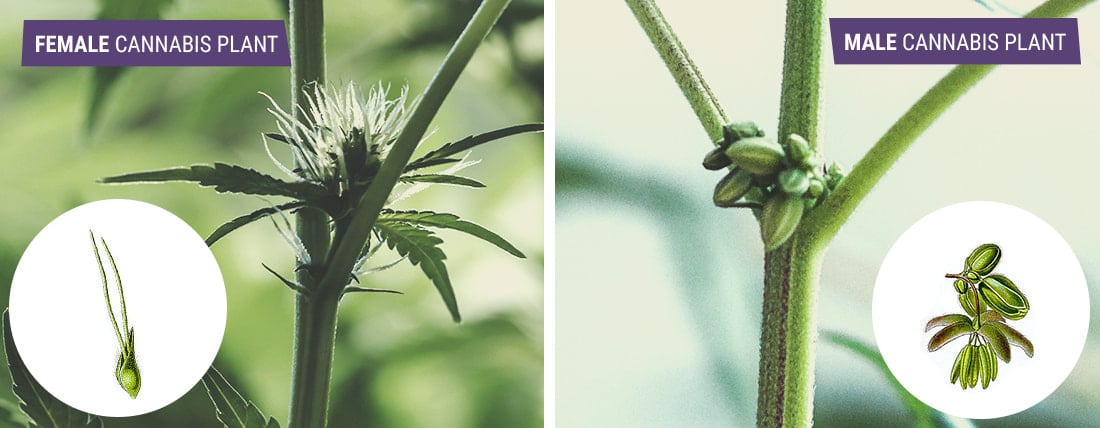
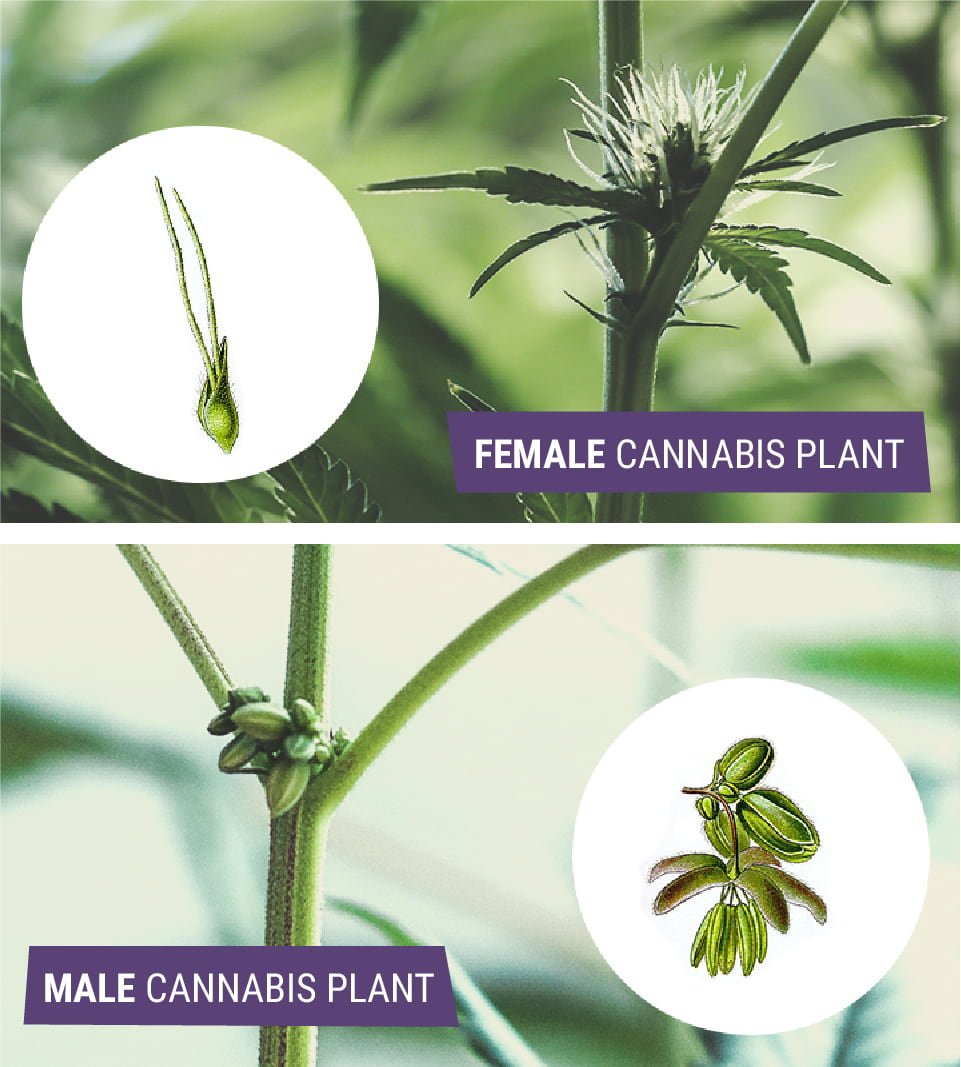
Hermaphrodites: When Cannabis Plants Become Monoecious
Cannabis, like those who love it, doesn’t always stick to the rules, though. Sometimes, this dioecious plant species goes against the grain and develops both male and female reproductive organs. These specimens are known as hermaphrodites. Either genetic or environmental factors, or both, can cause plants to develop this unusual trait. Having both buds and pollen sacs, they end up developing the ability to pollinate and reproduce with themselves.
Of course, growers want to avoid this phenomenon if they’re aiming for the best flowers possible. We’ll dive deeper into what causes hermaphroditism and how to avoid it below.
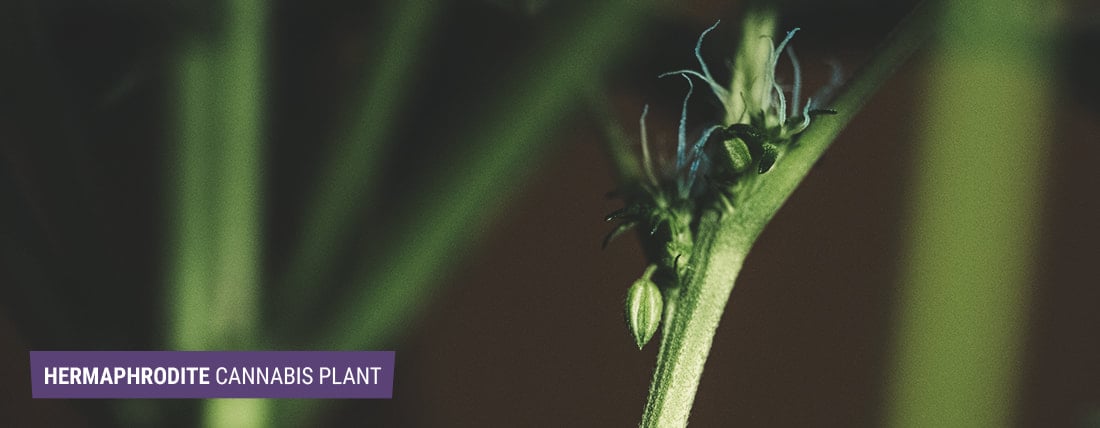
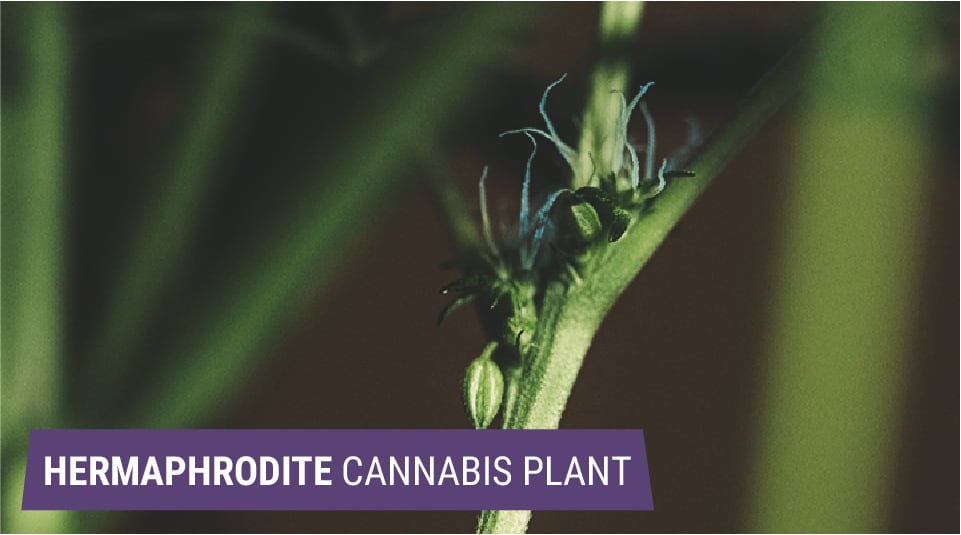
Can You Tell if Your Plant Is Male or Female Before Flowering?
Yes, thankfully. While males pose a threat to growers chasing nothing but resinous buds, you can prevent them from entering your grow room altogether if you know what to look for. You don’t have to wait for pollen sacs to develop—and risk them spilling their genetic material—in order to spot the males in your crop.
Before entering the flowering stage, cannabis plants begin to reveal their sex in the form of preflowers—the early developmental stage of buds and pollen sacs that form around the nodes (the point at which the branches and main stem meet). However, it takes some time—up to six weeks—for preflowers to display obvious male and female features.
-
How Soon Can You Tell if Your Plant Is Male or Female?
Luckily, male preflowers show key characteristics earlier than their female counterparts. This enables attentive cultivators to remove male plants from the growing space well before female plants start to bloom. Typically, males reveal their sex two weeks earlier than female plants. You can expect to see preflowers begin to appear by the sixth week of the growing cycle.
How To Identify Different Sexes Of Cannabis Plants: Sexing Cannabis
The ability to determine plant sex as early as possible is a critical skill for cannabis growers. Know as "Sexing Cannabis", as you develop this eye for identifying plant sex, you will be able to prevent any accidental pollination.
The goal: find the males and move them out of your grow room or garden as quickly as possible. The sex of a plant becomes fairly obvious during the early flowering stage, but time is of the essence in that regard. The quicker you can identify and remove male plants, the more you reduce the chances of accidental fertilisation.
-
Identifying Early Signs Of Male Plant
Growers identify plant sex by identifying pre-flowers, which are small structures that form at the nodes during late vegetation.
During the early flowering stage, take a stroll around your grow room or garden with a magnifying glass or jeweller’s loupe. Inspect a few nodes on each plant to see how far along into the flowering process they are. At this stage, you won’t see any obvious flowers or pollen sacs. Instead, you’re looking for young pre-flowers. Although these tiny structures look similar, they have distinct features that allow growers to tell them apart.
Male pre-flowers look like tiny green eggs or “balls”. These young pollen sacs will look smooth and won’t possess any fine hairs, or any distinct point. Later into the flowering stage, pollen sacs begin to form larger and denser clusters. They’ll become easy to identify with the naked eye by this point. However, pollen sacs usually begin to disperse their contents around 2–3 weeks after forming. Be sure to remove them from your space with haste if you don’t plan on crossing your plants.
The difference between male and female flowers becomes more obvious as they grow, but cultivators with a keen eye can tell them apart at the earlier stages. Male preflowers, anatomical landmarks known as staminates, are much more spherical. They feature a round sac accompanied by a long piece of protruding tissue. Together, these structures are referred to as the “ball and stick”. If left to develop, male preflowers will quickly transform into hanging sacs loaded with pollen. Other characteristics of male plants also help to give their sex away. These morphological differences include increased height, thicker stems, and fewer leaves.
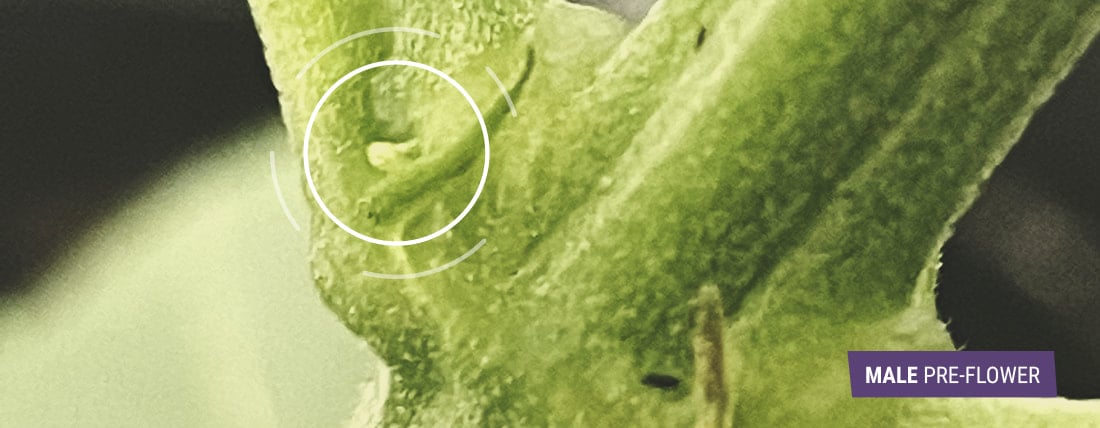
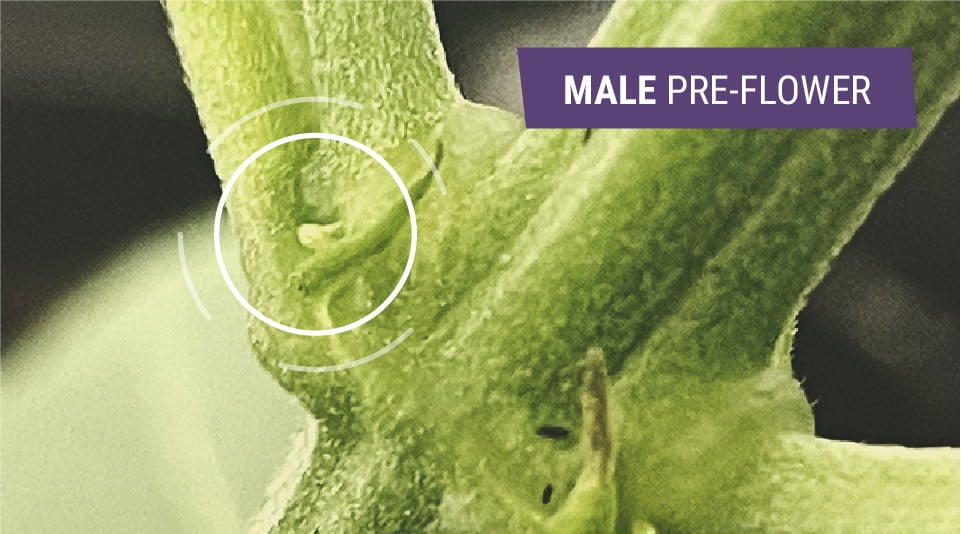
-
Identifying Female Cannabis Plants
Female pre-flowers also develop at the nodes. You can distinguish them based on one obvious visual characteristic: hairs. Female pre-flowers feature tear-drop shaped calyxes with small hairs protruding from the tip. These small hairs, known as pistils, are the sex organs of female cannabis flowers.
These protruding structures are designed to capture pollen, which leads to fertilisation. They stick out away from the flower to capture pollen from the air, and to await being brushed up against by pollen-covered insects.
Within a matter of weeks, these small pre-flowers swell into dense nuggets and begin churning out cannabinoid and terpene-rich resin. Since you the removed males and prevented pollination, your flowers will continuously produce resin until the end of the growing cycle.
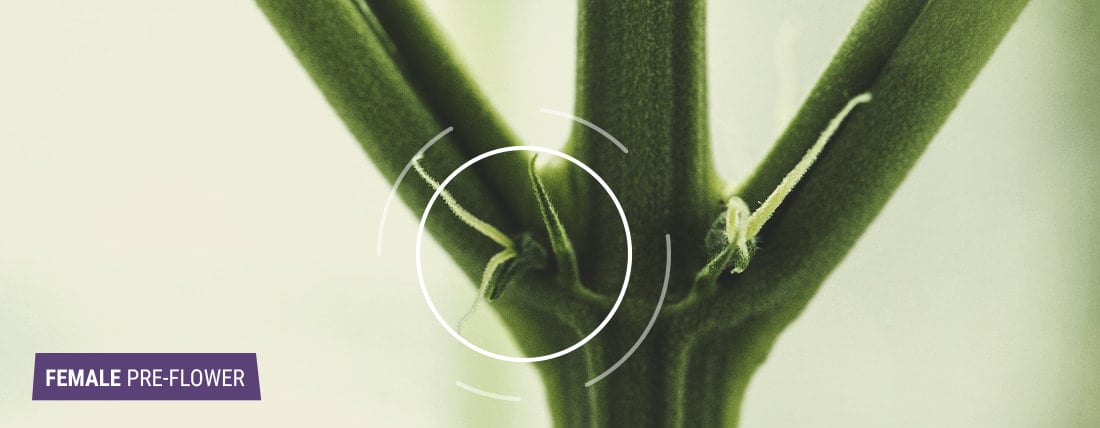
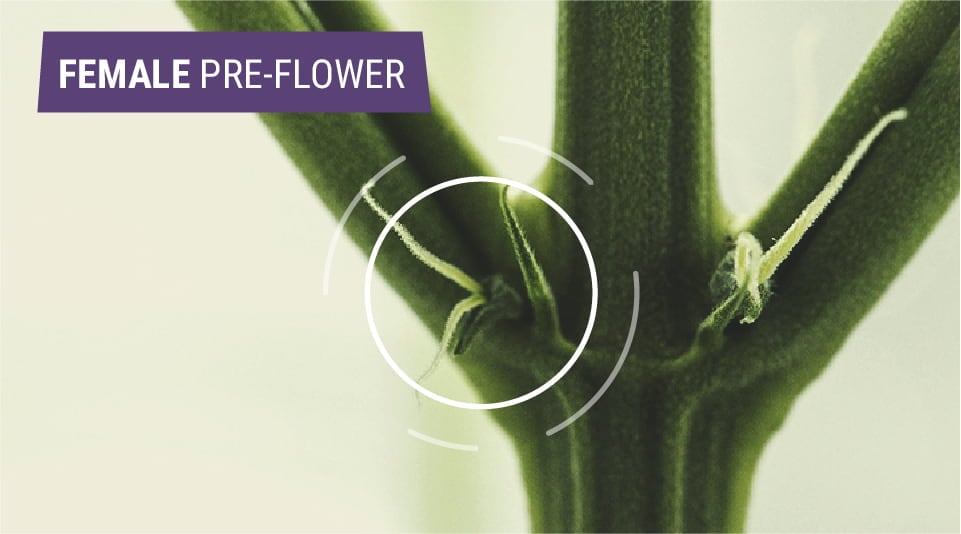
-
Identifying Hermaphrodite Cannabis Plants
Several factors can cause female plants to start to develop pollen sacs—or exposed stamens—alongside their flowers. This trait means that plants don’t need to rely on a nearby male to burst their sacs and fertilise them. As we’ll discuss in a bit, this is actually a savvy survival mechanism and a display of nature’s genius. However, hermaphrodites aren’t desirable in the grow room or garden. Now, let’s discuss both types and how to avoid the issues they cause.
Types Of Hermaphrodite Cannabis Plants
Hermaphrodite cannabis plants come in two different forms: true hermaphrodites and “bananas”.
The former features distinctly male and female reproductive flowers. Upon close inspection, you’ll notice male flowers occupying some nodes, and female flowers residing at others. When the pollen sacs rupture, the pollen will displace into the pistils, and the plant will effectively breed with itself. From there, it’ll produce seeds that will give rise to the subsequent generation.
“Banana” hermaphrodites get their name from their physical characteristics. Instead of producing separate male flowers, they only develop a bare stamen without sepals within the female flower. This naked appendage drops pollen directly onto buds to ensure self-reproduction. These stamens share a similar shape and colour to a certain tropical fruit, hence their name.
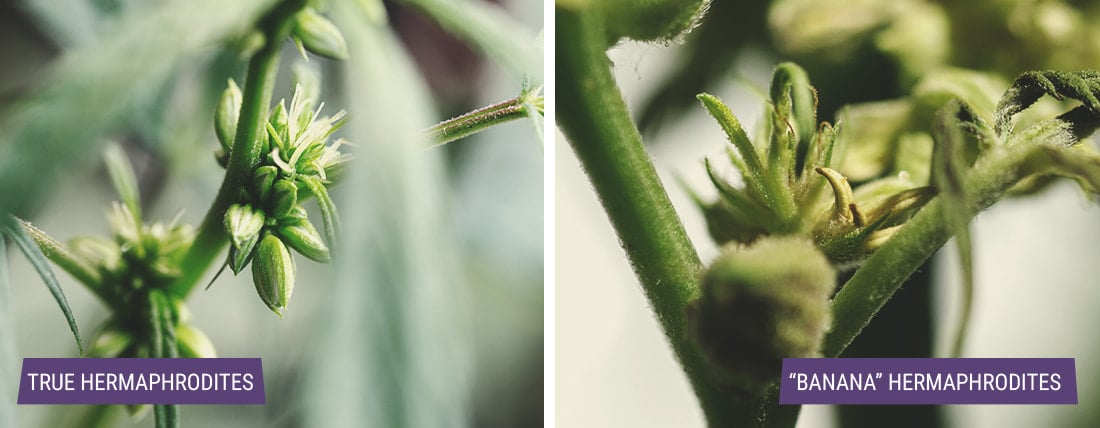
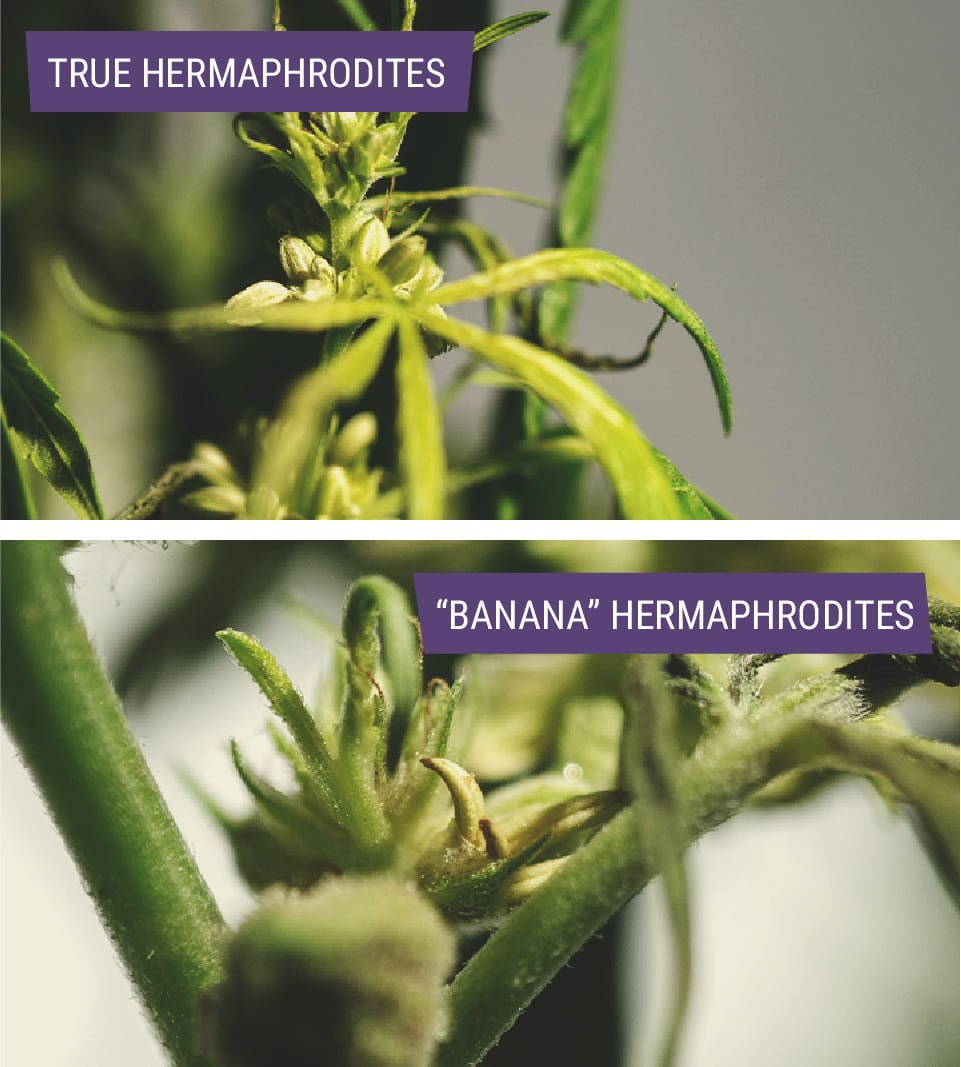
How To Avoid Hermaphrodite Plants In Your Grow Room
Hermaphroditism stems from two major driving factors: stress and genetics. In regards to stress, hermaphroditism serves as a survival mechanism. If a plant experiences damage, heat, disease, or nutrient deficiencies, they start to freak out. Essentially, plants get the impression that their time is up. In a last-ditch attempt to reproduce, they decide to stop waiting around for a male and get the job done themselves.
To avoid this issue, try to maintain a stable environment in your grow room. Use a thermo-hygrometer to monitor temperature and humidity, keep your light schedule strict, and ensure your plants get all the nutrients they require.
Even if you have all of these bases covered, plants can still pollinate themselves due to genetics. Plants with a bad genetic history can inherit genes associated with the expression of male flowers, producing hermaphrodites.
Prevent common growing mistakes. Download our grow guide to learn how to grow thriving cannabis plants!
Free RQS
Grow Guide!
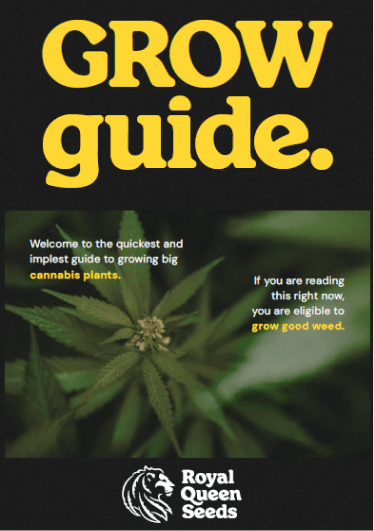
How Long Does Pollen Last in a Grow Room?
Under the right conditions, breeders can store pollen over a period of years for breeding purposes. However, this fertilising substance doesn’t last as long when exposed to the volatile environments of grow rooms and gardens. Pollen grains lose their viability upon exposure to water, heat, and light; these elements are commonplace within any growing environment.
Once a male plant opens its pollen sacs and spreads its genetic material, it only remains viable for a matter of days. If disaster strikes, the female plants in the vicinity will almost certainly divert their energy away from resin production and toward seed formation. While your current plants won’t turn out exactly the way you had hoped, this doesn’t mean you need to sterilise your entire grow room and all of your cultivation gear.
The pollen in the environment will lose its viability to less than 5% within approximately three days[1]. Considering you’re more careful with identifying sex going forward, you don’t have to worry about residual pollen contaminating your next wave of female plants.
What Type Of Cannabis Seeds Are Used For Breeding?
If you want to try breeding, you’re going to need regular cannabis seeds, and Royal Queen Seeds offers a premium range. In contrast to feminized seeds that produce only female specimens, regular seeds offer a 50% chance of the plant being male or female.
These seeds provide breeders with an army of males and females to experiment with. Cross the very best specimens together to create your own unique strains that match your taste. However, if you’re growing for nothing but buds, you can still use them for their stable and trusty genetics. As you may know, regular seeds provide excellent mother plants to produce clones and amazing yields. You’ll have to spot male plants, but the payoff will be more than worth it.
Can You Tell the Sex of a Cannabis Seed?
No. Believe us, we’d be thrilled if this was the case! No matter what your local ganja guru might tell you, growers simply can’t identify the sex of a plant based on staring at the seeds. Seeds aren’t plants. Without key anatomical areas to assess, such as preflowers, leaves, and stems, seeds provide absolutely zero clues about their future sex.
However, seeds do give away some indications regarding their quality. Their colour, sheen, size, shape, and even source serve as great means to predict their vitality. Unfortunately, these signs do nothing to point toward their fate as either a male or female plant.
The only way to know the sex of the seeds is by checking the DNA in the laboratory. For this, it would be necessary to extract the DNA from the embryo and apply molecular markers that detect regions of the male chromosome. Nonetheless, this method will destroy the seed and is highly expensive, so it is better to wait for the appearance of the preflowers to determine the sex.
- Humidity stress responses in pollen of anemophilous and entomophilous species https://www.tandfonline.com
 Grow Guide Topic Finder
Grow Guide Topic Finder
- Growing cannabis step by step
- Cannabis growing basics
- Choosing your seeds
- How to germinate seeds
- The cannabis vegetative stage
- The cannabis flowering stage
- Harvesting cannabis
- Trimming, drying, and curing
- Choosing pots and soil
-
Growing indoors
- A Complete Overview Of Growing Cannabis Indoors
- Cannabis Cultivation Tips: How To Set Up Indoor Grow Lights
- How Many Cannabis Plants Can You Grow Per Square Metre?
- Indoor Cannabis Growing: Relative Humidity and Temperatures
- Hydroponics Cannabis Growing Guide (with diagrams)
- Cannabis Micro Growing: Growing Great Weed in Tiny Spaces
- Growing outdoors
- How to grow autoflowering cannabis
- Cannabis nutrients and pH
- Cannabis troubleshooting: Nutrients
-
Cannabis troubleshooting: Growing
- Cannabis Seed Germination — Troubleshooting Guide
- How to Deal With Pythium (Root Rot) in Cannabis Plants
- Slow Cannabis Plant Growth And What You Can Do About It
- How to Deal With Leggy Cannabis Seedlings
- Watering Your Cannabis: How to Fix Overwatering and Underwatering
- Understanding Male, Female, And Hermaphrodite Cannabis
- Identifying and Treating Common Cannabis Ailments
- How To Revive a Sick Cannabis Plant
- How to Avoid Mouldy Weed During Drying and Curing
- How to Prevent and Treat Dry and Crispy Cannabis Leaves
- What Cannabis Leaves Can Tell You
- Causes and Solutions for Yellow Cannabis Leaves
-
Cannabis Strains Grow Report
- HulkBerry Automatic Grow Report
- Blue Cheese Auto Grow Report
- Purple Punch Automatic Strain Grow Report
- Triple G Automatic Grow Report
- Do-Si-Dos Automatic Grow Report
- Green Gelato Automatic Grow Report
- Haze Berry Automatic Grow Report
- Purple Queen Automatic Grow Report
- Cookies Gelato Automatic Grow Report
- Sherbet Queen Automatic Grow Report
- Sweet Skunk Automatic Grow Report
- Medusa F1 Grow Report
- Cannabis plant training
-
Weed growing tips
- The Cannabis Plant Anatomy
- How to preserve seeds
- How Much Sunlight Do Outdoor Cannabis Plants Need To Grow?
- How to Control and Prevent Stretching in Cannabis Plants
- My Cannabis Plants Are Growing Too Tall: What Should I Do?
- Should You Worry About Purple Or Red Cannabis Stems?
- What To Do When Your Indoor Cannabis Won’t Flower
- How To Protect Your Cannabis Plants From Heat Stress
- How To Tell If Your Female Cannabis Plant Has Been Pollinated
- Growing Medical Marijuana
- Bud Washing: How to Clean Your Weed
- Understanding Cannabis Yield per Plant


























